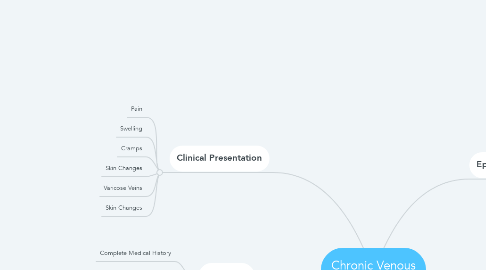Chronic Venous Insufficiency
by laura vandenberg

1. Clinical Presentation
1.1. Pain
1.2. Swelling
1.3. Cramps
1.4. Skin Changes
1.5. Varicose Veins
1.6. Skin Changes
2. Diagnosis
2.1. Complete Medical History
2.2. Physical examination, with thorough examination of the legs
2.3. Vascular or duplex Ultrasound
3. Treatment
3.1. Compression Stockings
3.2. Mobilization
3.3. Exercise program
3.4. Weight Loss
3.5. Elevate Legs
3.6. Antibiotics to treat infections (as a result of CVI)
4. Epidemiology
4.1. 2-5% of all Americans have some changes with CVI
4.2. Venous stasis ulcers affect approximately 500,000 Americans
4.3. Mean incidence of hospital admission for CVI is 92 per 100,000 admissions
4.4. <1% to 40% in females
5. Pathophysiology
5.1. Increased venous pressure transcends the venules to the capillaries, impeding flow
5.2. Low-flow states within the capillaries cause leukocyte trapping
5.3. Trapped leukocytes release proteolytic enzymes and oxygen free radicals, which damage capillary basement membranes
5.4. Plasma proteins (e.g. fibrinogen) leaking into the surrounding tissues forming a fibrin cuff
5.5. Interstitial fibrin and resultant edema decrease O2 delivery to the tissues, resulting in local hypoxia
5.6. Inflammation and tissue loss


